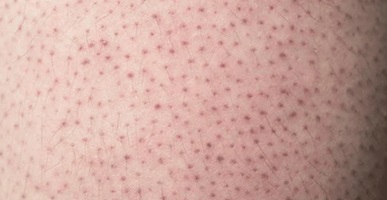Strawberry Skin: Causes, Treatment and Prevention
Strawberry Skin: Causes, Treatment and Prevention
Strawberry skin isn’t a word used in medicine. Instead, it’s a general term for spots that resemble strawberry seeds that emerge on your skin and might be red, brown, or black.
Usually, they are seen on the legs. The “strawberry” patches result from clogged pores or hair follicles.
Cosmetic dermatologist Matthew Janik, MD, described the black patches as resembling seeds on a pitted strawberry plate.
“They’re nontoxic, which is wonderful news. In most cases, a few easy at-home procedures can eradicate strawberry skin.
This mostly appears on the legs which is why many people refer to it as strawberry legs but it could be seen in other areas of the body.

Read on to learn more about strawberry skin.
Table of Contents
What is strawberry skin?
Over 40% of adults have Keratosis Pilaris (KP), a genetic skin disorder that is well-known by synonyms like “strawberry skin” or “chicken skin.”
Goosebumps-like lumps and dry, itchy skin, particularly on the backs of the upper arms, upper legs, and butt, are the main symptoms of the disorder.
The word “strawberry skin” does not have any definitive medical meaning.
It’s more of a catch-all term for spots that look like strawberry seeds, appear on your skin, and are brown, black, or red.
Usually, they are seen on the legs. The “strawberry” patches result from clogged pores or hair follicles.
Strawberry skin medical term
Strawberry skin usually looks like black spots that are caused by dirt and oil getting stuck in the hair follicles.
Keratosis pilaris, on the other hand, is a skin disorder that causes tiny red bumps because too much keratin builds up in the hair follicles.
Is strawberry skin genetic?
The accumulation of extra keratin in your hair follicles is the cause of keratosis pilaris, which is most common in those with dry skin or eczema.
Usually, those who have “strawberry legs” for the rest of their lives are just suffering from keratosis pilaris, which is a bothersome genetic condition.
In which areas are we likely to get strawberry skin?
Strawberry skin is mostly found on the legs but can also be seen in some other parts of the body, some of which are shown below:
Strawberry skin legs: The term “strawberry legs” describes a condition in which the skin’s blocked pores look like little seeds bearing strawberries.
Contrary to the fruit, however, it is something that many women wish to eliminate.
If you have strawberry legs, you can notice increased pores and dark patches on your skin that match your hair follicles.
Strawberry skin arms: Infamous for synonyms like “strawberry skin” or “chicken skin”, Keratosis Pilarisis is a genetic skin condition that affects over 40% of adults during their lifespan.
The condition is characterized by bumps that resemble goosebumps and itchy or dry skin, especially on the back of the upper arms, upper legs, and butt and mammary glands.
What are the symptoms of strawberry skin?
Although strawberry legs can mimic a variety of ailments, the following are typically indicative of the condition:
- The skin on your legs appears to be spotted or pitted
- The legs’ exposed pore areas become darker
- The development of dark or black spots on the legs following shaving
- You might have a strawberry leg-like underlying condition if you’re itching, scabbing, irritated, or inflamed.
- See your physician to determine the best course of action for treating your skin and to rule out any infections.
Strawberry skin causes
Raspberries can form on the legs for one of two reasons: first, if the hair surrounding the follicle is darker than the surrounding skin, or second if the pores and follicles are clogged and the trapped material oxidizes and darkens, creating an open condom or something similar.
Why do people get strawberry skin?
- Shaving incorrectly: When using a dull razor, shaving can result in razor burn, which can resemble strawberry skin, as well as infection of the hair follicles.
- Folliculitis: The legs are the most prevalent site of folliculitis, a common skin disorder. It happens as a result of infected and inflammatory hair follicles.
There are two types of folliculitis: superficial and deep.
It begins as little red pimples that may get darker over time and resemble strawberry skin.
Additional reasons for folliculitis could be:
- Razing and Waxing
- Dressing in tight clothing
- Skincare routines include exfoliation and hydrotherapy.
Keratosis pilaris: Also very common, keratosis pilaris causes small bumps to show up on the upper arms and legs.
These tiny, rough-to-the-touch lumps can resemble goosebumps, tiny pimples, or chicken skin.
These pimples may resemble strawberry skin when they cover the thigh.
A little buildup of dead skin cells is known as keratosis pilaris.
The following are a few typical causes of keratosis pilaris:
- Dry weather
- Chemicals in swimming pools
- The winter months
- Severe skin dehydration: Strawberries can also appear on very dry skin.
Strawberry skin is not directly caused by dry skin; however, having dry skin might lead to irritation or razor burns.
You can thus experience darkening of the pores or perhaps develop folliculitis.
- Problems with ingrown hairs: When you wax or shave your legs, your hair comes back unevenly, resulting in ingrown hairs.
If the hair becomes lodged beneath the skin, it can be an excruciating condition.
After shaving a leg, ingrown hairs may show themselves as:
- Tiny, black lumps
- Pus-filled bumps and darker areas of skin
- Pain or itching
- Acne: Your pores may be heavily congested due to acne.
Dead skin cells or oil become trapped in the skin as a result of increased sebum production.
Some people see blackheads or whiteheads that look like strawberry skin when they have acne.
Typical reasons for acne include:
- Hormone alterations
- Comedogenic cosmetics
- Elevated humidity
- Excess sweat
- Certain drugs
- Skintight garments
Strawberry skin treatment
Eliminating the circumstances that allow strawberry skin to develop is the key to learning how to get rid of it.
In this instance, it refers to moisturizing and exfoliating.
- If you have strawberry skin, you should start applying a cleanser or leave-on treatment that contains salicylic acid, a beta-hydroxy acid that is fond of sebum (your skin’s natural oil), immediately.
This should gradually remove the accumulation of substances in blocked hair follicles and pores.
- Clogged pores can also be cleaned with the aid of other chemical exfoliants. Alpha-hydroxy acids (AHAs), such as lactic acid and glycolic acid, are effective in dissolving and removing impurities from the skin.
As an alternative to salicylic acid, which occasionally irritates delicate skin, AHAs can be quite helpful.
Many AHAs and BHAs can dry out skin; therefore, lactic acid’s hydrating qualities make it an excellent AHA for sensitive skin.
- The next step in getting rid of strawberry skin is to treat dry skin.
The chemical exfoliation will remove the extra dead skin cells that come with dry skin, but they won’t stay away.
That can only be accomplished by raising the skin’s overall moisture level.
This is achieved by first facilitating the skin’s ability to absorb water and then by enhancing its ability to hold onto that water.
- Using a chemical exfoliant in a cleanser will help dry skin absorb moisture by removing the outer layer of dead skin cells; then, using the right moisturizing procedures will help maintain hydration.
To maximize the absorption of moisturizer into damp skin, apply it while the skin is still damp from a shower or bath.
This will keep the surface water from evaporating and provide deeper hydration.
Ceramides, a type of lipid found in abundance in skin and a component in numerous moisturizers, are one option to consider.
Applying an oil coating to seal this in gives the skin the best opportunity to retain as much moisture as possible for the longest period.
- If hydrating and exfoliating strawberry skin doesn’t work, the visible hairs may merely be darker-colored than the surrounding skin, rather than plugged pores and follicles.
If so, the only option to “treat” this specific type of strawberry skin would be to use a hair removal technique that destroys the follicle.
This includes waxing, epilation, and laser hair removal.
It’s crucial to remember that these techniques take time to show noticeable, long-lasting effects and may inflame the hair follicles.
See a dermatologist if the strawberry skin in issue doesn’t improve with more hydration, exfoliation, or hair removal at the follicle.
A serious infection could be the cause.
Strawberry skin treatment at home
Is there anything I can do at home to eliminate strawberry legs?
- Using a premium razor, shave in a grainy manner.
- Use a cloth or a physical scrub to exfoliate.
- After shaving, apply lotion.
- Every time you shave, use shaving gel.
- An appropriate exfoliation.
- Moisturizing frequently.
- Using retinol or salicylic acid products
- Making use of mild cleaners.
- Showers at room temperature or cold.
- Using sea salt
Conclusion
In most cases, a person can treat or avoid strawberry legs by adjusting their self-care routine.
For instance, they might begin shaving their legs with a sharp razor and shaving lotion.
Regularly exfoliating and hydrating strawberry skin can prevent and treat it.
A person should consult their doctor about any underlying infections that might be the cause of strawberry legs if home therapies are ineffective.
These infections are generally easily treated.
FAQs
How do I get rid of strawberry skin face?
Strawberry skin on the face
- It is very beneficial to use creams that contain jojoba oil, glycerin, lanolin, or shea butter.
- For optimal hydration retention, apply the cream while your body is still slightly moist.
- Wash your body using a damp washcloth, a loofah, or an exfoliant.
Dead skin cells that can obstruct pores are removed during exfoliation.
Is chicken skin and strawberry skin the same?
Because of the way this skin condition looks, it’s commonly referred to as “strawberry skin” or “chicken skin.”
The most prevalent locations for keratosis pilaris are the thighs, cheeks, butt, and backs of the upper arms.
Can strawberry skin go away naturally?
Keratosis pilaris cannot be cured, but it can be lessened in appearance.
Retinoids, moisturizers, exfoliants, and other products are used as treatments. Keeping up with skincare regimens helps avoid strawberry skin/legs.
If keratosis pilaris is not improved by at-home remedies, see a dermatologist.
Can strawberry skin go away on its own?
These clogged pores can affect people of any skin tone, although they tend to look darker on lighter skin types.
The good news is that strawberry skin diseases are typically not associated with major health problems.
Strawberry skin can occasionally heal itself without any medical intervention.
Which cream is best for strawberry legs?
Be Bodywise 200ml of 5% AHA Body Lotion with 48-Hour Moisturization that has been dermatologist tested, improves skin texture, and lessens the appearance of strawberry skin.
It contains Cica and Aloe Vera extracts.
Can coconut oil remove strawberry skin?
To remove any spots on your legs, you can also try doing occasional oil massages using olive, coconut, or any other essential oil.
You can avoid the awkward strawberry patches on your legs by using homemade scrubs three times a week.
How long does strawberry skin take to go away?
Whether you employ professional or at-home treatments, dermatologists advise that it may take two to six weeks for the treatment to take effect.
Strawberry legs can be eliminated with hair removal, exfoliation, and moisturizers, all of which can be done at home or by a professional.
What oil is good for strawberry legs?
After shaving or waxing, apply a mixture of water with pure aloe vera and a few drops of tea tree oil frozen in a sphere to your legs.
This is known as strawberry legs. This keeps your pores free and soothes and hydrates your skin.
What is the best medicine for strawberry skin?
Keep in mind that the skin on your face is more delicate than average when you listen to our recommendations for exfoliants to clear out your pores and reduce oil production.
Even very sensitive skin can be safely treated with mild exfoliants like glycolic acid or salicylic acid when dealing with strawberry skin.
How do I prevent strawberry skin on my face?
Keep in mind that the skin on your face is more delicate than average when you listen to our recommendations for exfoliants to clear out your pores and reduce oil production.
Even very sensitive skin can be safely treated with mild exfoliants like glycolic acid or salicylic acid when dealing with strawberry skin.
Can aloe vera remove strawberry skin?
Strawberry legs can be eliminated with the use of aloe vera, which can address the majority of their causes, including dry skin, infections, and hard shaving.
It can help mend damaged skin, is high in antioxidants, and hydrates your skin just enough to give it a smooth, youthful appearance.
Does shea butter help with strawberry legs?
After exfoliating, apply natural moisturizers to the affected regions, such as shea butter, coconut oil, or aloe vera gel.
These substances can nourish the skin, improve its texture, and lessen the appearance of black spots because of their moisturizing and calming qualities.
Does Kojic Acid remove strawberry legs?
If you have strawberry legs due to Keratosis Pilaris, this is the perfect fit for you!
We especially adore it for helping with that condition!
You can’t go wrong with glycolic acid exfoliation, which helps remove dead skin cells and fight blemishes, and kojic acid exfoliation, which amplifies chemical exfoliation and reduces hyperpigmentation.
Do celebrities have strawberry legs?
A build-up of dead skin cells and clogged or enlarged pores are two possible causes of these tiny, black bumps that resemble the surface of a fresh strawberry.
Cinderellas, Beyoncé, and other celebrities have all, surprisingly, suffered from strawberry legs.
Can lemon remove strawberry legs?
Benign skin conditions like this one can be easily cured with common household staples like lemon, brown sugar, and baking soda.
You can have softer legs by hydrating and exfoliating your skin.
How often should I exfoliate strawberry skin?
When you don’t exfoliate frequently—try to do it two to three times per week—oil and dead skin cells clog your pores.
When using a dull razor, you won’t get a smooth shave; instead, the blades will tug and pull at your hair.
How can I make my legs smooth without strawberry skin?
Strawberry-skinned legs
After using a fresh washcloth or loofah to exfoliate your legs, moisturize to maintain the moisture levels in your skin.
In addition to making legs seem better, moisturizing can stop further outbreaks.
But stay away from goods that have dyes or scents in them.


